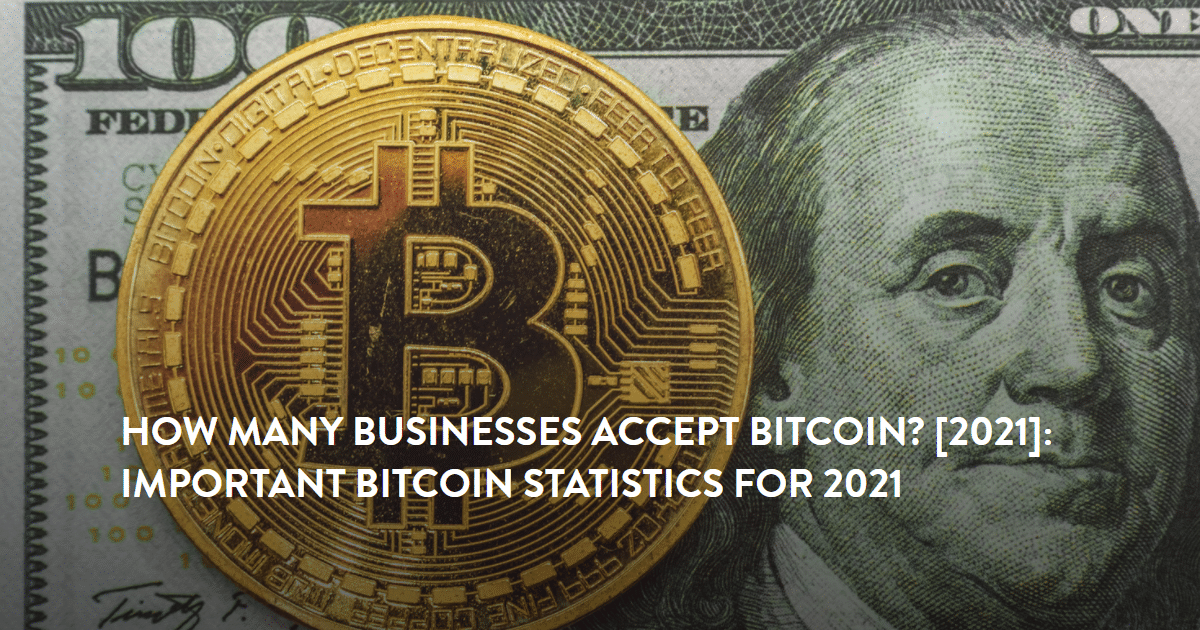- Tech Industry Statistics
- MFA Statistics
- Streaming Services Statistics
- Mobile Vs. Desktop Usage Statistics
- AI Statistics
- Live Streaming Statistics
- Zoom Meeting Statistics
- Cord Cutting Statistics
- Digital Transformation Statistics
- Virtual Reality Statistics
- How Fast Is Technology Advancing
- Mobile Commerce Statistics
- SaaS Statistics
- Machine Learning Statistics
- Diversity In High Tech
- Cyber Security Statistics
- Ecommerce Statistics
- Tech Industry
- Gaming Industry
- Renewable Energy Job Creation
- Smartphone Industry
- Cybercrime Statistics
- Amazon Statistics
- Personalization Statistics
Research Summary. In the last decade, mobile technology has improved significantly and now many people use their smartphones as often, if not more, to perform tasks such as emailing, browsing the web, or running computer applications. Here are some key statistics about the differences between mobile and desktop usage:
-
60% of website traffic worldwide comes from mobile devices.
-
51% of website traffic in the United States comes from mobile technology.
-
About half of the time spent online is through mobile technology.
-
Between 2017 and 2022, global mobile data traffic increased about 573%.
-
83% of social media interactions in North America occur through mobile technology.
For further analysis, we broke down the data in the following ways:
Global Stats | Mobile Usage | U.S. Stats | User Behavior
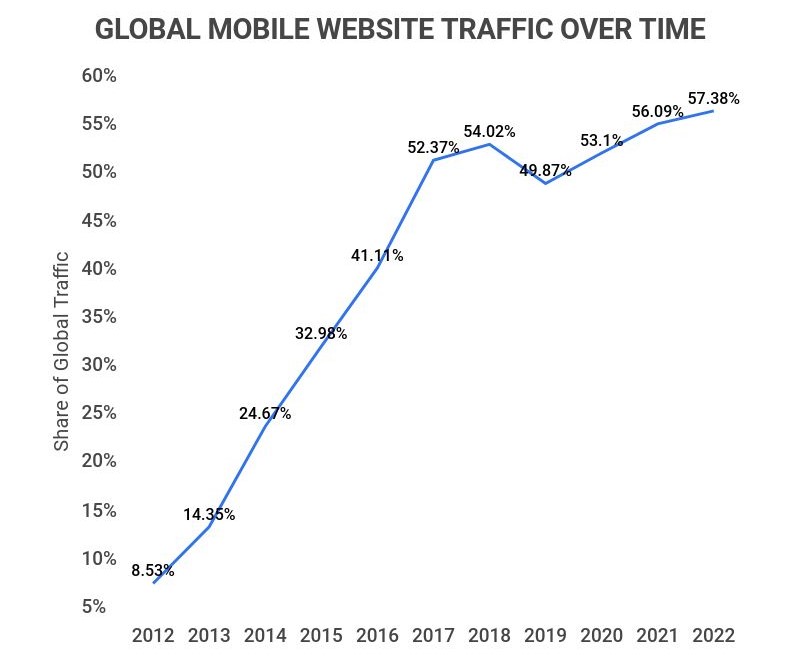
General Mobile Vs. Desktop Statistics
-
63% of search engine searches in the U.S. are through mobile technologies.
Likely due to their convenience and prevalence in our lives, most of us search for things using our phones.
-
15% of internet users only use mobile phones in the U.S.
These are people who either can not have or do not want traditional broadband access to the internet. Instead, they are willing to rely on their mobile phone data plans to provide them access.
-
November 2016 was the first time mobile traffic surpassed desktop traffic worldwide.
This is a watermark in the history of the internet because it shows a specific point in time when people were able to use their phones instead of desktops to perform tasks through the internet.
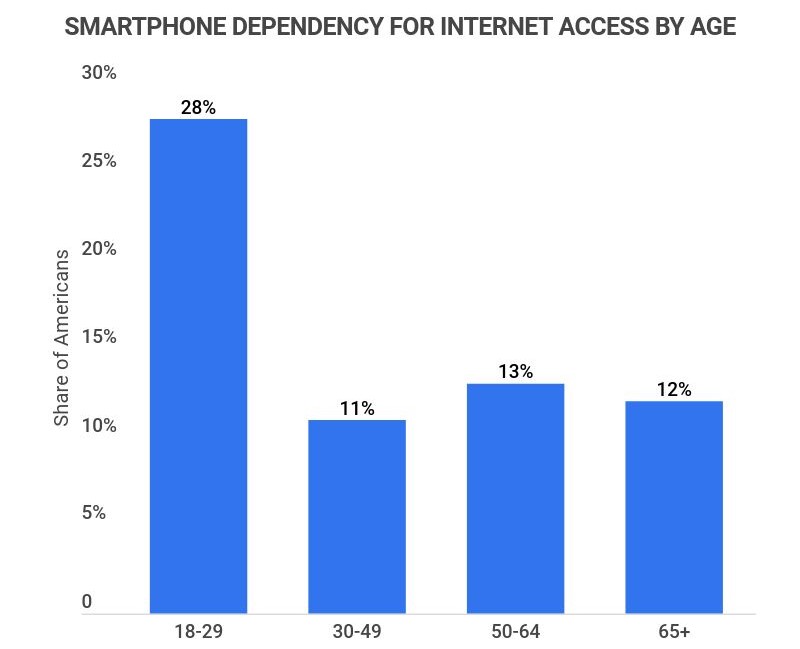
Global Mobile Vs. Desktop Statistics
-
4.97 billion people worldwide access the internet with their mobile devices.
This is about 90% of all global internet users. This statistic shows that almost everyone going on the internet will do so using a mobile phone at least once.
-
The tablet internet market share worldwide stands around 2.4%.
This can be explained by a variety of factors. Most people who have a tablet also have a phone with internet access. Mobile phones are still more convenient in most settings for people, while desktops still have a functional role to play in many professions.
-
Most social media and entertainment apps are used through mobile technologies.
As this table breaks down, mobile usage dominates the share for most social media and entertainment apps. This is not too surprising since these apps are designed to be used almost anywhere while capturing people’s attention.
Social Media Mobile Usage
App Mobile Usage Share (%) Twitter 80 Facebook 81 LinkedIn 57 YouTube 63 Reddit 72
Time Spent On Mobile And Desktop By Country
| Country | Total time spent on devices (in hours) | Time spent on Internet via mobile | Time spent on Internet via desktop |
|---|---|---|---|
| South Africa | 10:46 | 5:09 | 5:37 |
| Philippines | 10:27 | 5:47 | 4:40 |
| Brazil | 10:19 | 5:25 | 4:54 |
| Colombia | 10:03 | 5:09 | 4:54 |
| Argentina | 9:38 | 5:04 | 4:34 |
| Malaysia | 9:10 | 4:49 | 4:21 |
| Thailand | 9:06 | 5:28 | 3:38 |
| Mexico | 8:55 | 4:37 | 4:18 |
| Indonesia | 8:37 | 4:56 | 3:41 |
| UAE | 8:36 | 4:35 | 4:01 |
| Taiwan | 8:07 | 4:12 | 3:55 |
| Saudi Arabia | 8:05 | 4:35 | 3:30 |
| Egypt | 8:02 | 4:25 | 3:37 |
| Turkey | 8:00 | 4:16 | 3:44 |
| Portugal | 7:56 | 3:34 | 4:22 |
| Russia | 7:50 | 3:39 | 4:11 |
| Israel | 7:35 | 3:31 | 4:04 |
| Singapore | 7:28 | 3:38 | 3:50 |
| India | 7:18 | 4:05 | 3:13 |
| Romania | 7:09 | 3:41 | 3:28 |
| United States | 7:04 | 3:30 | 3:34 |
| Hong Kong | 6:46 | 3:31 | 3:15 |
| Canada | 6:45 | 2:51 | 3:54 |
| Poland | 6:40 | 2:58 | 3:42 |
| Vietnam | 6:38 | 3:32 | 3:06 |
Mobile Usage Statistics
-
Americans spend, on average, 4.1 hours a day on their cell phones.
This is a growing number. Americans are increasingly using their cell phones as part of their daily life. Consider that 4 hours is about 25% of the time we spend awake.
-
iOS commands a 59% market share of U.S. cellular usage, while Android comes in second at 40%.
iPhones are the most popular choice among American consumers, which explains why their operating software dominates the market.
-
Mobile apps have a conversion rate three times as large as mobile sites and 1.5 times as large as desktop sites.
Mobile apps, with their targeted ads and specified consumer base, are able to be more effective in converting users into buyers.
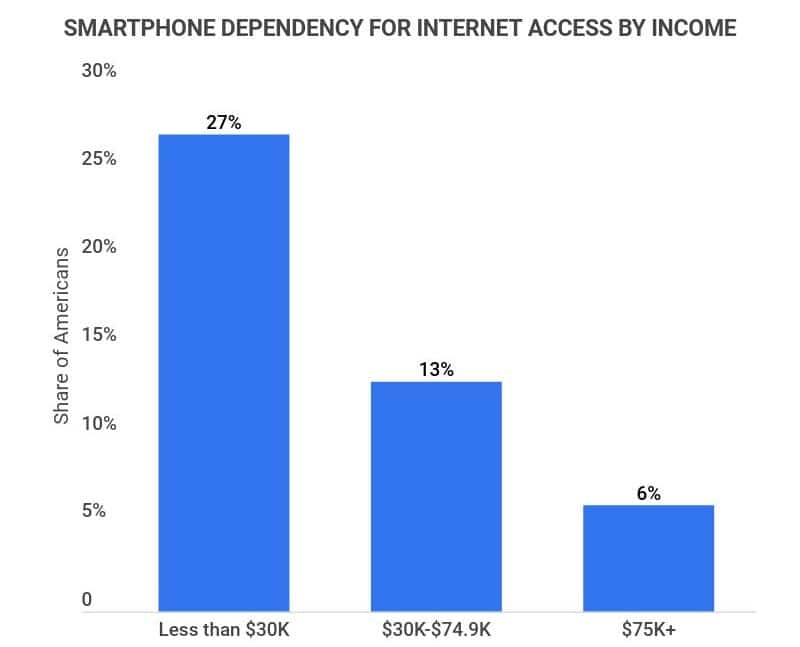
U.S. Mobile Vs. Desktop Statistics
-
83% of U.S. residents access the internet with their smartphones.
This shows that nearly all Americans are able to use their phones to go on the internet. Regardless of frequency, mobile technology is rooted in American society.
-
Americans spend about 4.1 hours a day on their phones, compared to 3.5 hours a day on a desktop.
This is about 36 minutes, or 2.5% more time in the day, spent on phones compared to desktops. Such a difference is understandable as we take our phones wherever we go during most of the day.
-
Younger generations are much more likely to use their phones instead of desktops for internet usage.
Not surprisingly, older generations are more comfortable with desktops, which have been around longer. Also, it can be assumed that younger generations are going to be on the internet more and will do so with the phones they carry around.
Mobile, Desktop, and Tablet Usage By Age
Age Range Mobile Usage (%) Desktop Usage (%) Tablet Usage (%) 18-24 79 19 2 25-34 68 29 3 35-44 60 37 3 45-54 54 41 5 55-64 41 53 6 65-74 30 62 7 75+ 15 76 8
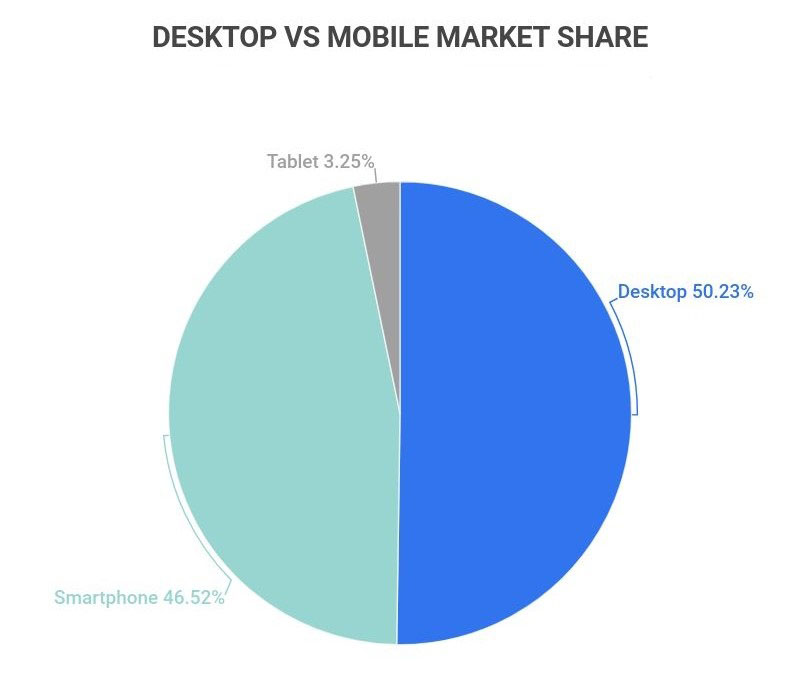
Mobile Vs. Desktop Statistics by User Behavior
-
Mobile users in the U.S. are 11% more likely to bounce from sites or applications when compared to desktop users.
This shows that mobile users are not as committed to the information they are accessing as desktop users are.
-
Mobile users spent 49% less time on sites than desktop users.
The mobile user is a fleeting customer. They average only about 158 seconds per page, while desktop users spend about 323 seconds per page visit. This means that the attention of mobile users must be grabbed quickly if a site wishes to retain its viewership.
Mobile Vs. Desktop Usage Statistics FAQ
-
What percentage of global internet traffic is mobile?
60% of global internet traffic is mobile. This number has grown significantly since the introduction of mobile internet technology in the early 21st Century, and it continues to grow, with global internet traffic through mobile devices increasing 573% over the last five years.
This means mobile users cannot be denied as an important gateway to the internet for users. Mobile technology and data have provided affordable and convenient internet access in parts of the globe that lack the necessary resources for a desktop-based society.
-
Are there more mobile users than desktop users?
Globally there are more mobile users, while in the U.S., it is more evenly split. Mobile usage makes up about 56% of the global share, compared to desktop usage at 41%. Meanwhile, mobile usage makes up about 51% of the market share, while desktop usage stands at 49%. In both cases, the remaining usage is through tablet technologies.
This difference between global and domestic mobile usage makes sense when you consider how the infrastructure and developed economy of the U.S supports desktop usage.
Also, consider the fact that desktop technologies arrived first, and the U.S. integrated them into their society a lot sooner than most of the world. In other parts of the globe, mobile technology is booming because it is more accessible.
-
What percentage of the U.S. internet traffic is mobile?
51% of internet traffic in the U.S. is mobile. As the statistics above show, the U.S. still has a thriving desktop market in part due to its longevity compared to mobile technology. Also, it should be remembered that desktops are important in many professional and academic settings.
-
Is YouTube more popular on mobile or desktop?
YouTube is more popular on mobile technologies, with mobile viewing accounting for 63% of total viewership. This is, in part, thanks to the YouTube app, which allows users easy access to its videos. The YouTube app is intuitive to most people’s needs, such as accessing videos in situations when a desktop is not present.
-
What country uses the most mobile data per capita?
Finland uses the most mobile data per capita at about 34 GB/month per person. This is nearly 10 GB more than the next country, Taiwan. This has been attributed to several factors in the Finland economy that promote mobile usage.
Finland has the infrastructure to provide reliable service. There are also affordable data plans that provide high volume usage. Finally, the geographic layout of Finland’s population is intuitive to mobile usage.
Conclusion
Clearly, mobile internet usage cannot be ignored. Domestically, the U.S. sees a near-even split between mobile and desktop usage. However, when we delve deeper, we notice that younger generations are increasingly using their mobile devices over desktops.
This trend can be expected to continue, and as these groups get older, they will take up a more important role in the U.S. economy.
What’s more, around the world, users are turning to mobile devices as a means to access the internet. Any relevant business that wishes to expand will want to continue to invest in its mobile presence.
As a result, in the coming years, it can be expected that mobile technology will be promoted more than desktop technology. This will then compound the popularity of mobile technology, likely making it the dominant form of computer access for most consumers.
References
-
Perficient. “Mobile vs. Desktop Usage in 2020.” Accessed April 14, 2022.
-
Statista. “Distribution of daily time spent online via mobile and PC by internet users worldwide from 2013 to 2019.” Accessed April 14, 2022.
-
Oberlo. “What Percentage of Internet Traffic is Mobile?” Accessed April 14, 2022.
-
Statista. “Mobile social media worldwide – Statistics & Facts.” Accessed April 14, 2022.
-
GlobalStats. “Desktop vs Mobile vs Tablet Market Share United States Of America Mar 2021 – Mar 2022.” Accessed April 14, 2022.
-
Google Case Studies. “Twitter Lite PWA Significantly Increases Engagement and Reduces Data Usage.” Accessed April 14, 2022.
-
Findstack. “The Ultimate List of LinkedIn Statistics for 2022.” Accessed April 14, 2022.
-
eMarketer. “Compared to Facebook and Twitter, Reddit Has Room to Grow on Mobile.” Accessed April 14, 2022.
-
Pew Research Center. “Mobile Technology and Home Broadband 2021.” Accessed April 14, 2022.
-
CNET. “Americans spent a third of waking hours on mobile devices in 2021, report finds.” Accessed April 14, 2022.
-
Eventya. “Why Mobile Apps Have Higher Conversion Rates Than Websites.” Accessed April 14, 2022.
-
Comparitech. “Screen Time Statistics: Average Screen Time in US vs. the rest of the world.” Accessed April 14, 2022.
-
EMI Research Solutions. “The Link Between Device Usage and Age: Impacts on Results.” Accessed April 14, 2022.
-
Telegeography. “Finns Lead the Way in Mobile Data Usage.” Accessed April 14, 2022.
-
Statista. “Percentage of mobile device website traffic in the United States from 1st quarter 2015 to 2nd quarter 2022” Accessed March 28, 2023.
-
Statista. “Percentage of mobile device website traffic worldwide from 1st quarter 2015 to 4th quarter 2022” Accessed March 28, 2023.
-
Statista. “Internet usage in the United States – Statistics & Facts” Accessed March 28, 2023.
-
Statista. “Mobile internet usage worldwide – Statistics & Facts” Accessed March 28, 2023.
-
Statista. “Global mobile data traffic from 2017 to 2022” Accessed March 28, 2023.
-
Statista. “Mobile search – Statistics & Facts” Accessed March 28, 2023.
- Tech Industry Statistics
- MFA Statistics
- Streaming Services Statistics
- Mobile Vs. Desktop Usage Statistics
- AI Statistics
- Live Streaming Statistics
- Zoom Meeting Statistics
- Cord Cutting Statistics
- Digital Transformation Statistics
- Virtual Reality Statistics
- How Fast Is Technology Advancing
- Mobile Commerce Statistics
- SaaS Statistics
- Machine Learning Statistics
- Diversity In High Tech
- Cyber Security Statistics
- Ecommerce Statistics
- Tech Industry
- Gaming Industry
- Renewable Energy Job Creation
- Smartphone Industry
- Cybercrime Statistics
- Amazon Statistics
- Personalization Statistics




